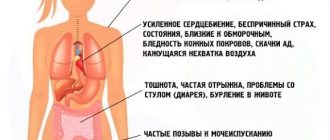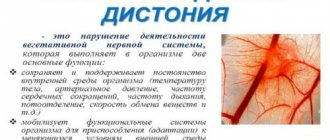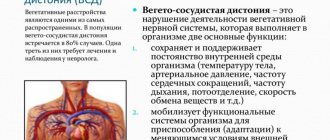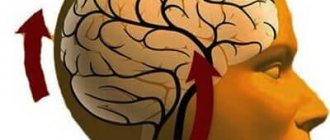4 / 5 ( 4 voices)
Every 3 people in the country live with vegetative-vascular dystonia, some do not pay attention to the symptoms of the pathology, others are forced to adapt to circumstances and depend on medications all their lives. In some patients, VSD occurs of the hypotonic type, in others of the hypertensive type, in others of the abdominal or other type.
In this article we will talk about what is VSD of the hypertensive type, how does this condition manifest itself and can it be cured?
Pressure measurement in the photo
What is VSD of the hypertensive type?
Vegetative-vascular dystonia of the hypertensive type is not a separate disease, but a series of disorders in the functioning of the nervous system, which is manifested by specific clinical symptoms. One of the characteristic signs of hypertensive type VSD is an increase in blood pressure.
Vegetative-vascular dystonia implies a complex of clinical symptoms caused by a violation of the neurocirculatory function of the nervous system. The autonomic division of the nervous system is responsible for the functioning of vital organs.
Many processes in the body (the work of the gastrointestinal tract, breathing, blood supply to blood vessels, the act of swallowing and others) occur thanks to the autonomic nervous system. When the functioning of this part of the nervous system is disrupted, malfunctions occur in many organs and systems, which is manifested by a variety of clinical symptoms.
VSD of the hypertensive type, as a separate disease, is not included in the international classification of diseases, therefore, according to ICD-10, this pathology is noted as hypertension. The international name for vegetative-vascular disorders is neurocirculatory dysfunction, and the ICD-10 code for VSD of the hypertensive type depends on the clinical signs that predominate in the patient. In view of this, the pathology can be classified as a disorder of a psychogenic nature or as secondary arterial hypertension.
Prevention
To prevent the development of pathology, it is necessary to exclude (minimize) the influence of negative factors. To do this, you should adhere to the principles of a healthy lifestyle: give up bad habits, eat nutritiously, engage in feasible physical exercise and avoid stress.
Good benefits will come from normalizing your weight, as well as the habit of relaxing actively in the fresh air. If you have chronic diseases, you should pay more attention to your health, periodically being examined and treated. Such activities will have a very positive effect on your health, helping to prevent the development of many dangerous disorders in the body.
Vegetative-vascular dystonia of the hypertensive type is a common disease, the development of which is preceded by many negative factors. VSD is diagnosed in both adults and children and adolescents. If such a problem is detected, it is imperative to reconsider your rhythm of life, diet and physical activity. Successful treatment for severe cases will be provided by folk remedies, physiological procedures, as well as individually selected drug therapy.
Did you like the article? Save it!
Still have questions? Ask them in the comments! Cardiologist Mariam Harutyunyan will answer them.
Ivan Grekhov
Graduated from the Ural State Medical University with a degree in General Medicine. General practitioner
Symptoms
Headache
Signs of VSD of the hypertensive type are divided into objective and subjective symptoms, this is more clearly presented in the table.
| Symptoms of VSD | What does this mean? |
| Subjective, that is, those that the patient himself complains about | These symptoms are also classified as psychosomatics, since a full examination shows that no significant disturbances in the functioning of internal organs and systems were detected, and yet the patient complains of specific signs of the disease:
|
| Objective – identified disturbances in the functioning of the cardiovascular system, confirmed by diagnostic studies | The doctor can easily diagnose these symptoms already during the patient’s first visit to him:
|
Important! An increase in blood pressure in a patient with VSD is directly related to the work of the nervous system (autonomic), which regulates vascular tone.
With neurocirculatory dysfunction of the hypertensive type, both a persistent increase in blood pressure and periodic crises are noted. At the time of crisis, all the symptoms of the pathology intensify several times, for example, systolic pressure can exceed 170-180 mm Hg.
Weakness and ringing in the ears
In patients with VSD, in most cases there is a change in heart rhythm - the pulse rate can be either too high or below normal. Rapid pulse (tachycardia) exceeds 100 beats/min, at these moments the patient is restless, excited, the carotid artery is pulsating, which is visible to the naked eye.
Bradycardia is said to exist if the heart rate is less than 60 beats/min, but with high blood pressure this condition practically does not occur. A decrease in heart rate is typical for patients who have taken too large a dose of tranquilizers or psychotropic drugs. This condition is characterized by drowsiness, weakness, “wobbly” legs, dizziness, and a feeling of lack of air.
Causes of vascular dystonia
Infectious lesions of brain tissue can provoke a pathological change in the tone of the vascular walls. Disturbances in the functioning of the blood supply system to the head are caused by:
- oxygen starvation of fetal brain tissue during intrauterine development;
- birth injuries;
- damage to the skull and soft tissues of the head as a result of accidents, accidents, sports injuries;
- spinal injuries in the cervical region;
- disruptions in the functioning of the endocrine system;
- dyskinesia (impaired contraction of the bladder and ducts) of the biliary tract;
- pathologies of the liver and gastrointestinal tract;
- allergic reactions;
- hereditary predisposition.
Stress and psycho-emotional tension contribute to the development of a functional disorder. Cerebral circulation insufficiency has dangerous consequences. The most serious of them are tissue atrophy, stroke, heart attack, disability, and the need for constant medical supervision and maintenance.
Causes
Chronic lack of sleep leads to VSD
The main reason for the development of VSD of the hypertensive type is a disruption of the autonomic nervous system.
The following factors can provoke such a violation:
- regular lack of sleep - a person’s sleep should be at least 8-9 hours, and it is imperative to go to bed no later than 10 pm;
- unhealthy diet – abuse of sausages, herbs, spices (these products have a stimulating effect on the body and nervous system);
- stress;
- excessive physical activity;
- abuse of coffee and alcohol;
- smoking;
- hereditary predisposition;
- various diseases of the nervous system;
- excessive psycho-emotional and mental stress.
Alcohol abuse as one of the causes of VSD
Most often, the first signs of VSD occur in adolescents during active puberty, which is due to the peculiarities of the growth of organs and systems, against the background of which the nervous system does not have time to adapt to the changes taking place.
In addition, teenagers tend to eat dry food, snack on the go, or skip meals. Poor nutrition, coupled with excessive sitting at the computer, negatively affects the autonomic nervous system and can lead to malfunctions in its functioning.
VSD in adolescents
Also, signs of VSD of the hypertensive type often occur in women during pregnancy and are caused by serious hormonal changes in the body, to which the vegetative system does not always have time to adapt. Stress, anxiety and fear for the health of the unborn baby aggravate the symptoms of neurocirculatory dysfunction, making a woman nervous, tired, irritable and psycho-emotionally exhausted.
Vascular dystonia of the brain
Dystonia of blood vessels in the brain is detected in 80% of people who go to the doctor with complaints of neurological disorders - headache, general malaise, weakness. The cause of regular headaches is often vegetative-vascular dystonia, a disorder that is not even included in the international registry of diseases ICD-10 (ICD-10).
Depending on the predominant symptoms, the pathology can be classified according to international criteria as encephalopathy, dysfunction of the autonomic nervous system, somatoform dysfunction of the autonomic system. Manifestations of VSD of the brain are similar to signs of neurosis or mental disorder.
Diagnostics
Blood pressure measurement at the doctor
The diagnosis of VSD should be differentiated from pathologies that have similar symptoms:
- hypertonic disease;
- angina pectoris;
- heart failure;
- atherosclerosis of heart vessels;
- hyperthyroidism.
The patient should visit a number of specialists - a cardiologist, neurologist, endocrinologist, and in some cases a psychotherapist.
To differentiate VSD from the above pathologies, the patient needs to undergo a number of tests and undergo some studies:
- blood tests - biochemistry, general, hormones T3, T4 and TSH;
- electrocardiogram;
- Ultrasound of the vessels of the head and neck using Doppler;
- MRI of the head and all parts of the spinal column.
How is the disease diagnosed?
Before making a diagnosis of VSD of the hypertensive type, doctors conduct a comprehensive examination, because the symptoms of the disease may be similar to other diseases. Diagnosis begins with collecting anamnesis; the doctor needs to know when the first symptoms began and what exactly they are, how often they appear, whether there have been cases of autonomic nervous function disorders in the family, if there are any chronic or acute diseases, especially cardiac, vascular or endocrine. The doctor conducts a physical examination, including examination of the skin, palpation of the lymph nodes, listening to the pulse, heartbeat and breathing.
During diagnosis, a cardiac electrocardiogram (ECG) is required, which most often shows the absence of murmurs and heart rhythm disturbances, which gives the doctor the opportunity to exclude cardiac pathology. Rheovasography is also performed - a procedure through which you can make a graphical graph of pulse fluctuations and track how the vessels of tissues and organs fill with blood. The patient should be examined by specialized specialists such as a cardiologist, neurologist, endocrinologist, pulmonologist, therapist and gastroenterologist.
Blood and urine tests are required. If during the examination the doctor does not find any disease that causes certain symptoms against the background of high blood pressure, a diagnosis of vegetative-vascular dystonia of the hypertensive type is made.
Important! After a doctor diagnoses a disease, you cannot decide on your own how to treat the pathology. Treatment of VSD of the hypertensive type is selected strictly by the doctor who made the diagnosis.
How do blood pressure levels change with neurocirculatory dysfunction?
A patient suffering from hypertensive VSD exhibits a stable increase in blood pressure of 140/90 mm Hg. Under stress, physical exertion, and fear, blood pressure can reach up to 180 mm Hg during diastole. A notable difference between VSD and true hypertension is that high blood pressure levels stabilize at rest on their own, whereas with hypertension this is impossible without taking antihypertensive drugs.
A long-term persistent increase in blood pressure during VSD can lead to a so-called crisis, and then the patient requires qualified medical care.
How to treat VSD and is it even possible?
How to cure vascular dystonia?
Treatment of neurocirculatory dysfunction of the hypertensive type involves specific and symptomatic therapy.
Specific treatment includes prescribing medications to the patient, the action of which is aimed at normalizing the functioning of the autonomic nervous system. As a rule, these are sedatives, B vitamins, and magnesium preparations. Symptomatic treatment involves the use of medications that lower blood pressure.
Important! Medications for high blood pressure should only be selected by a doctor, since incorrect calculation of the dose of the drug can lead to the development of acute vascular insufficiency and orthostatic collapse.
Lifestyle of a patient with VSD
Physical exercise
Perhaps the main criterion for successful treatment of vegetative-vascular dystonia is lifestyle correction.
Below are instructions for simple actions that can, if not completely eliminate the signs of VSD, then significantly reduce their intensity:
- Night sleep should be at least 8-9 hours;
- give up coffee and various drinks that stimulate the nervous system;
- eat a balanced and nutritious diet - meals should be regular, at least 4 times a day, with the last meal no later than 3 hours before bedtime;
- walk in the fresh air every day and do simple physical exercises - during times of crisis, stress is excluded;
- stop watching TV and sitting at the computer for a while;
- bad habits are eliminated.
It is important to create a favorable psycho-emotional environment, since stress and anxiety aggravate the course of VSD.
Diet food
Diet
A diet for VSD involves excluding from the diet foods that excite the nervous system and can provoke surges in blood pressure.
These products include:
- coffee, alcohol;
- chocolate, cocoa;
- pork, offal;
- spices;
- seasonings, spices;
- mushrooms;
- sausages;
- smoked meats;
- canned food and pickles.
It is important not to overeat; after eating, the patient should remain a slight feeling of hunger. Preference is given to vegetables, fruits, dairy products, lean fish and white chicken meat.
Important! If, despite taking medications, the patient continues to eat everything, drink coffee and alcohol, smoke and sleep little, then drug therapy will not lead to any result. Drugs for VSD only complement complex treatment, the greatest effectiveness of which lies in the correction of lifestyle and nutrition.
Drug treatment
Valerian tincture
How to treat VSD with medication? First of all, medications are individually selected for the patient, which improve the functioning of the nervous system, relieve stress from it and reduce the tone of blood vessels.
Such drugs include:
Phenazepam tablets
- sedatives - as part of complex therapy courses, the patient is prescribed courses of herbal tinctures, Valerian motherwort tablets;
- antidepressants;
- antihypertensive drugs - their use is appropriate only in moments of crisis with a pronounced increase in blood pressure;
- nootropic drugs - they improve cerebral circulation and increase concentration;
- tranquilizers.
Persen tablets
Important! The listed groups of drugs have a large list of contraindications and possible side effects. Many of them are contraindicated during pregnancy and breastfeeding. To avoid the serious consequences of self-medication, never prescribe treatment for yourself or on the recommendations of friends.
Physiotherapeutic treatment
When acute clinical manifestations of neurocirculatory dysfunction subside, the patient is recommended to undergo physiotherapeutic treatment.
The most effective methods for treating VSD and normalizing the functioning of the nervous system are:
- massage of the cervical-collar area, head, upper limbs4
- exercise therapy;
- manual therapy;
- aromatherapy.
Many patients suffering from VSD have noted significant improvements in their condition after practicing yoga.
Forecast
Unfortunately, it is almost impossible to completely cure VSD, since disturbances in the functioning of the nervous system are only a consequence of some abnormalities in the body. As a rule, a complete change in lifestyle and the elimination of stress can achieve stable remission of the condition.
Some patients note pronounced signs of VSD only in adolescence, during pregnancy and in moments of severe stress; after surviving these periods, improvement usually occurs without the use of medications.
Definition of pathology
To understand what cerebral vascular dystonia is, it is worth remembering the regulation of the activity of the circulatory system. Nervous regulation of arterial tone is carried out using the processes of the sympathetic nerves, which are abundantly supplied to the vessels. Excitation of the sympathetic nerves leads to the production of the mediator norepinephrine, which acts on the smooth muscle tissue of the vascular walls.
The essence of malfunctions in the functioning of the body during vegetative-vascular dystonia is a pathological change in the tone of the walls of the arteries and small highways of the cerebral circulation circuit. Vascular tone becomes unstable and may increase or decrease. A functional disorder in the central nervous system leads to an increase or decrease in blood pressure. Moreover, deviations from the norm are episodic in nature, but are often repeated.
If vascular dystonia that occurs in the brain is not treated, chronic disturbances in the functioning of the circulatory system develop, which over time causes a weakening of blood flow and a deterioration in the supply of oxygen to tissues. Diseases that are associated with hypoxia are angina, ischemia, brain atrophy, stroke, cerebral infarction. Cerebral dystonia leads to deterioration in performance and negatively affects the quality of life.











